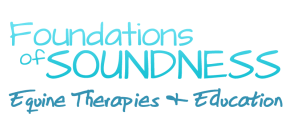Rehab can be as challenging and frustrating a road as it is rewarding, so when you’re in it for the long haul, it’s the little things that matter… and are totally worth celebrating! Today? It was building on the square halts we got using the poles the other day, and getting them with balanced downward transitions from voice. Why?
Because, for the neurological horse, it isn’t just about engagement and strength; it also means their proprioception is improving…and that is always an exciting achievement. Ollie’s deficits are not the reason he is in rehab, although I believe it was a contributing factor to both his injuries (impressive jumping ambitions and a Houdini complex do not mix with poor body awareness!). He is most obvious when walking downhill, and has been busted striking some strange poses, the classic lack of awareness and ataxia associated with wobbler syndrome. Thankfully, he is comparatively mild, and I am able to monitor him carefully for any subtle changes…because although compression of the spinal cord might be incurable, proprioception is quite a fluid thing. It can be improved and manipulated, and that’s a huge advantage to any horse, not just a wobbler.
How? Well, I have a bigger piece on that topic in the pipeline, but for this morning’s session, we warmed up with lots of labyrinth and pole work, creating patterns in and out and focusing on supple, careful turns.
I didn’t actually have to do much, as Ollie tunes in so quickly with this work that he follows my line, nose to my back or hand, even on the more difficult turns. Using the cavesson with the central ring, corrections are minimal and subtle, as he just “follows his nose”.
As Manolo Mendez explained it, the head and the spine are like a train: it’s easier to derail the train if you apply pressure under the chin or off centre, but leading from the centre of the nose, the rest of the spine flows easily along the tracks.
These things seem so basic, but the effect is profound. Ollie’s posture this morning while grooming held more of his habitual bracing and tension patterns, despite cracking a stubborn bodywork issue recently. Yet, by the time we have warmed up, walking over and around the poles and tracing suppling lines across the arena, he has already changed, and can pick up the very first trot transition in balance. And even though we are mostly working in walk, he walks out of that arena looking like a completely different horse – proud, balanced and connected; relaxed, grounded and confident.
Someone asked about the cavesson yesterday – mine is a Spanish serreta that has been widened and heavily padded, as they can be extremely sharp if used crudely and a flat option was not available at the time. Manolo Mendez Dressage offer a gentler version which is more appropriate for those without the refined skills to use a traditional serreta, who wish to have the stability of the solid nosepiece. If you have a delicate flower like Ollivander, sheepskin sleeves are very cheap from most saddleries and allow room for extra padding underneath!
Stay tuned for more tips and tricks (a handful of those in our toolbox include tape, body wraps and a few hacks for proprioception from the ground up…), and an upcoming 5-part rehab article series on the Foundations of Soundness blog!
Disabled and doubly neurodivergent human, former equine anatomist and bodyworker (no longer practicing due to Ehlers Danlos Syndrome complications), experienced equine advocate and educator, and budding disability advocate turning my sights on Australian Government policy and practice while elevating lived experience in research for horses and humans alike.
This blog is currently inactive but I occasionally check in on Facebook. Please check out the articles I keep it alive for and take something home to your horse ❤️


I would be very interested in reading more about improving proprioception and your tips on body wraps and tape